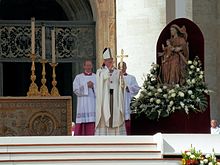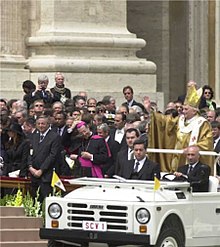Papal inauguration

Papal inauguration is a liturgical service of the Catholic Church within Mass celebrated in the Roman Rite but with elements of Byzantine Rite for the ecclesiastical investiture of a pope. Since the inauguration of Pope John Paul I, it has not included the 820-year-old (1143–1963) papal coronation ceremony.
It was in the 11th century that the inauguration took the form of a coronation.[1] Along with other ceremonies used at papal inaugurations,[2][3] a coronation became part of a pope's inauguration ritual from the time of Pope Nicholas II (1059–1061)[4] until 1963. Pope Paul VI, the last pope to be crowned or to use a papal tiara, abandoned the use of his tiara in a ceremony at the end of the second period of the Second Vatican Council.
Over twenty tiaras are held in the Vatican. That of Paul VI is in the crypt of the Basilica of the National Shrine of the Immaculate Conception in Washington, D.C.
A small one is still used to symbolically crown a statue of Saint Peter on his saint's day every year. The first pope for over eight centuries to inaugurate his pontificate without a coronation was Pope John Paul I.
Abandonment of the coronation
Pope Paul VI, the last pope to be crowned or to use a papal tiara, abandoned the use of his tiara in a ceremony at the end of the second period of the Second Vatican Council, and announced that it would be sold and the money obtained would be given to charity; it was in fact bought by Catholics in the United States and is now kept in the Basilica of the National Shrine of the Immaculate Conception in Washington, D.C.[5]
Though Paul VI decided not to wear a tiara, his 1975
His successor,
In his 1996 apostolic constitution
Modern inauguration
Four modern popes have now used an inauguration ceremony without coronation: Pope John Paul I, Pope John Paul II, (both in 1978), Pope Benedict XVI (2005) and Pope Francis (2013).
The modern papal inauguration, developed from the form used for John Paul I, takes place during
Pope Benedict XVI maintained those changes and also shortened, as explained below, the ceremony of homage previously paid at a papal inauguration by each cardinal individually, repeating the "act of homage and obedience" made in the conclave to the new pope before the announcement of his election to the people.[6]
The ceremony does not include the alleged Papal Oath that some
Inauguration of Benedict XVI
This article appears to be slanted towards recent events. (January 2014) |

Receiving the pallium and the Ring of the Fisherman
The pope received the pallium and the Ring of the Fisherman. Cardinal Jorge Medina, the cardinal protodeacon, formally bestowed the pallium on the pope.[7] The pallium used was different from that of previous popes: it was an earlier form practically identical to the ancient omophorion (still used to this day by Eastern bishops); wider than the standard archiepiscopal pallium, though not as wide as the modern omophorion; 2.4 metres (2.6 yards) long, made of wool with black silk tips. It had five embroidered red silk crosses instead of the six black ones of the normal archbishops' pallium. Pope Benedict later in his pontificate would use a pallium similar to that of his immediate predecessors, but with a longer, wider cut and six red crosses.
After the pallium was bestowed and before the Ring of the Fisherman was presented, Cardinal Stephen Kim Sou-hwan, as the senior cardinal-priest, pronounced the formal prayer for the new pope.[7]
Cardinal Angelo Sodano, as the senior cardinal-bishop, formally presented the Ring of the Fisherman to the pope.[7]
Act of homage
Instead of having each of the more than one hundred
After the ceremony
After Mass, Pope Benedict greeted inside St. Peter's Basilica, before the main altar, various delegations present for his inauguration. In the days following, he visited the other
Inauguration of Francis
Pope Francis celebrated his papal inauguration on 19 March 2013, the
Francis first descended to the tomb of St. Peter in St. Peter's Basilica where, along with the patriarchs and major-archbishops of the Eastern Catholic Churches, he prayed at the tomb.[10] Then the pallium and the Ring of the Fisherman were carried up from the tomb by two deacons to be borne in procession.[10] Then the pope and the Eastern Catholic patriarchs and major-archbishops returned to the main floor of the basilica and processed along with the other cardinals, bishops and other clergy to the square chanting the Laudes Regiae.[10]
Cardinal
Liturgical book
Ad hoc rituals were used for the inaugurations of the pontificates of Popes John Paul I and John Paul II. On 20 April 2005, Pope Benedict XVI approved a permanent rite, a draft of which had been made by the Office of Liturgical Celebrations of the Supreme Pontiff under John Paul II. This was published as an official liturgical book of the Church with the name Ordo Rituum pro Ministerii Petrini Initio Romae Episcopi (Order of the Rites for the Inauguration of the Petrine Ministry of the Bishop of Rome). Archbishop Piero Marini, the Papal Master of Ceremonies, described it as part of the application to papal rites of the liturgical reforms that followed the Second Vatican Council.
The Ordo contains not only the rite of the Mass of the Inauguration, but also that of the Mass of the Enthronement on the cathedra romana, the chair of the Bishop of Rome, in the Lateran Basilica, Rome's cathedral and the Catholic Church's primary basilica, outranking even the St. Peter's Basilica. Popes usually take possession of the Lateran Basilica within a few days of the inauguration of the pontificate.
Shortly before he resigned, Pope Benedict XVI introduced some modifications: strictly non-sacramental ceremonies take place not within Mass but either before Mass or without Mass; the individual act of homage by each cardinal is restored; a wider choice of music is provided; and the time for taking possession of the basilicas of Saint Paul Outside the Walls and Saint Mary Major is not limited to the two or three weeks following the inauguration.[15][16]
List of papal inaugurations since 1978
| Date | Location | Pope | Cardinal | Protodeacon of |
|---|---|---|---|---|
| Sunday, 3 September 1978 | Saint Peter's Square, Vatican City
|
John Paul I | Pericle Felici | Sant'Apollinare alle Terme Neroniane-Alessandrine
|
| Sunday, 22 October 1978 | Saint Peter's Square, Vatican City | John Paul II | Pericle Felici | Sant'Apollinare alle Terme Neroniane-Alessandrine
|
| Sunday, 24 April 2005 | Saint Peter's Square, Vatican City | Benedict XVI | Jorge Medina | San Saba |
| Tuesday, 19 March 2013 | Saint Peter's Square, Vatican City | Francis | Jean-Louis Tauran | Sant'Apollinare alle Terme Neroniane-Alessandrine
|
See also
Notes
- ^ The senior cardinal-priest or protopriest reads the prayer, but in the absence of Senior Cardinal-Priest Paulo Evaristo Arns the next senior, Godfried Danneels, read it.
References
- ^ Kantorowicz, Ernst Hartwig (1946). Laudes Regiae. University of California Press. p. 137. Retrieved 27 January 2015.
- ISBN 9781571132406. Retrieved 27 January 2015.
- ^ The Quarterly Review (London). John Murray. 1814. p. 249. Retrieved 27 January 2015.
- ISBN 9781136623356. Retrieved 27 January 2015.
- ^ Dugan, George (1 December 1964). "Spellman's Surprise: Pope's Tiara Is Here". The New York Times. Retrieved 24 February 2017.
- ^ Universi Dominici Gregis, 89
- ^ YouTubeRetrieved 12 April 2013.
- ^ Pope Benedict XVI Starts His Papacy. AmericanCatholic.org article on Pope Benedict XVI's inauguration. Retrieved April 13, 2013
- ^ "Dolan: Pope Francis Healthy Enough To Lead World's Catholics". NY1.com. Archived from the original on 2013-06-15. Retrieved 2013-03-22.
- ^ YouTube
- ^ "L'Omelia di papa Francesco".
- ^ "Papa Francesco indossa pallio e anello del pescatore, inizia Messa". Archived from the original on 2014-05-05. Retrieved 2014-12-01.
- ^ Laura Smith-Spark et al: Thousands pack St. Peter's Square for Pope Francis' inauguration CNN, 19 March 2013
- ^ Rolandi, Luca (2013-03-19). "Il giorno di Papa Francesco: La messa di inizio pontificato in Piazza San Pietro" (in Italian). Archived from the original on 2017-08-08. Retrieved 2013-10-15.
- ^ Modifications Made to Rites for the Beginning of the Pontificate
- ^ "Catholic News Service: "Pope Benedict changes rituals for new pope's inauguration"". Archived from the original on 2013-03-05. Retrieved 2013-07-19.
